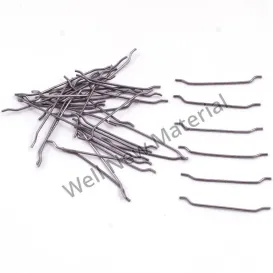FAQs | Everything You Need to Know About Steel Fiber in Concrete
Steel fiber is a critical material in the construction industry, offering significant benefits in enhancing the performance and durability of concrete. These small, discrete pieces of steel are added to concrete to improve its mechanical properties, making it stronger and more resilient. This article delves into the advantages, applications, and considerations of using steel fiber in concrete, providing a comprehensive understanding for industry professionals and enthusiasts alike.
What is Steel Fiber?
Steel fiber refers to short, thin strands of steel that are mixed into concrete to improve its properties. The fibers can be straight, hooked, crimped, or twisted, with each shape contributing differently to the concrete's performance. Typically, these fibers are made from carbon steel or stainless steel and are added to the concrete mix in varying proportions depending on the required performance criteria.

How Does Steel Fiber Enhance Concrete?
Steel fibers enhance concrete in several key ways:
Improved Tensile Strength: Steel fibers increase the tensile strength of concrete, which is naturally weak in tension. This makes the concrete more resistant to cracking and splitting under stress.
Enhanced Flexural Strength: By distributing stress more evenly throughout the concrete, steel fibers enhance its flexural strength, allowing it to bend without breaking.
Increased Durability: Steel fibers help to prevent the formation of micro-cracks and control the propagation of larger cracks, significantly increasing the durability and lifespan of concrete structures.
Better Impact Resistance: Concrete reinforced with steel fibers can absorb and dissipate energy more effectively, improving its resistance to impact and dynamic loads.
Reduced Shrinkage and Creep: Steel fibers mitigate shrinkage and creep in concrete, helping to maintain its shape and structural integrity over time.
Applications of Steel Fiber in Concrete
Steel fiber is used in a variety of applications in the construction industry, including:
Industrial Floors: Steel fiber-reinforced concrete is ideal for industrial floors due to its high strength and durability, which can withstand heavy loads and constant use.
Pavements and Overlays: The enhanced properties of steel fiber-reinforced concrete make it suitable for pavements and overlays, providing a longer lifespan and reduced maintenance costs.
Shotcrete: Used in tunneling and mining, steel fiber-reinforced shotcrete offers improved support and stability, reducing the risk of collapse.
Precast Concrete Products: Steel fibers are used in precast concrete products like pipes, tanks, and panels, enhancing their strength and durability.
Bridges and Tunnels: The high strength and durability of steel fiber-reinforced concrete make it ideal for use in bridges and tunnels, where structural integrity is crucial.
How to Determine the Right Proportion of Steel Fiber
The proportion of steel fiber to be added to concrete depends on several factors, including the desired mechanical properties, the specific application, and the mix design. Generally, the fiber content ranges from 0.25% to 2.5% by volume of concrete. It is important to conduct thorough testing and consult relevant standards to determine the optimal fiber content for each specific application.
Mixing and Placing Steel Fiber-Reinforced Concrete
Proper mixing and placing techniques are essential for achieving the desired properties of steel fiber-reinforced concrete:
Mixing: The fibers should be uniformly distributed throughout the concrete mix to ensure consistent performance. This can be achieved using standard mixing equipment, with adjustments made to accommodate the addition of fibers.
Placing: Care should be taken during placing to prevent the segregation of fibers and ensure an even distribution. Standard concrete placement techniques can be used, with additional compaction methods if necessary.
Finishing: Steel fiber-reinforced concrete can be finished using traditional methods. However, additional care may be needed to avoid pulling fibers to the surface and to achieve a smooth finish.
Benefits of Using Steel Fiber in Concrete
The benefits of using steel fiber in concrete are numerous:
Enhanced Structural Performance: The addition of steel fibers improves the overall structural performance of concrete, making it stronger and more resilient.
Cost-Effective: While the initial cost of steel fibers may be higher, the long-term savings from reduced maintenance and extended lifespan make it a cost-effective solution.
Versatility: Steel fiber-reinforced concrete can be used in a wide range of applications, from industrial floors to precast products, offering flexibility in design and construction.
Sustainability: The use of steel fibers can contribute to more sustainable construction practices by reducing the need for additional reinforcement and extending the lifespan of concrete structures.
Challenges and Considerations
Despite its advantages, there are some challenges and considerations when using steel fiber in concrete:
Cost: The initial cost of steel fibers can be higher than traditional reinforcement methods, which may be a consideration for budget-sensitive projects.
Workability: The addition of fibers can affect the workability of concrete, making it stiffer and more difficult to place and finish. Proper mix design and placement techniques are essential to overcome this challenge.
Corrosion: While stainless steel fibers offer excellent corrosion resistance, carbon steel fibers may be susceptible to corrosion in aggressive environments. Appropriate measures should be taken to protect the fibers and ensure long-term durability.
Conclusion
Steel fiber is a valuable addition to concrete, offering significant enhancements in strength, durability, and performance. By understanding the properties, applications, and considerations of using steel fiber, construction professionals can optimize their concrete mixes for a wide range of projects. Properly managed, steel fiber-reinforced concrete provides a cost-effective, versatile, and sustainable solution for modern construction needs.
- Previous: None
- Next: None


